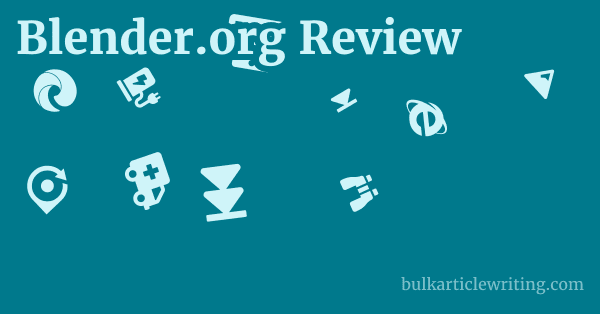Understanding the strengths and weaknesses of any software, particularly an open-source powerhouse like Blender, is crucial for prospective users.
Read more about blender.org:
Blender.org Review & First Look
Is Blender.org Legit? Unpacking Its Credibility
Blender.org Features: A Deep Dive into its Capabilities
Blender.org does an excellent job of showcasing the undeniable advantages, while the inherent nature of community-driven development also implies certain aspects that might be perceived as challenges by some.
The Major Pros of Blender.org and its Software
Blender.org presents a compelling case for its software through its detailed feature descriptions, community focus, and transparent operations. The advantages are numerous and impactful:
- Free and Open Source Software (FOSS): This is arguably Blender’s biggest advantage. It means anyone can download, use, and even modify the software without any licensing fees. This eliminates financial barriers to entry for individuals, students, and small studios, democratizing access to professional-grade 3D tools. The “GNU GPL” license ensures it remains free “forever.”
- Comprehensive Feature Set: As highlighted on the website, Blender is a true all-in-one 3D suite. It includes modeling, sculpting, UV unwrapping, texturing, rigging, animation, rendering (Cycles and Eevee), VFX (compositing, motion tracking), video editing, and 2D animation (Grease Pencil). This integrated workflow saves time and money by eliminating the need for multiple specialized software packages.
- Active and Supportive Community: The sheer volume of community resources—forums, tutorials, user stories, and the annual Blender Conference (BCON25)—is staggering. This means new users have abundant learning materials, and experienced users can find solutions, share knowledge, and collaborate. The “Find Blender Communities” section on the website is a gateway to this vibrant ecosystem.
- Continuous Development and Updates: Blender is not static. The website showcases frequent updates like Blender 4.4, Blender 4.3, Blender 4.2, Blender 4.1, Blender 4.0, and Blender 3.0. The “Blender Development” section with “Projects Update – Q2/2025” and details on experimental builds demonstrates a robust and ongoing commitment to improvement and innovation. This ensures the software remains cutting-edge and responsive to user needs and industry trends.
- Cross-Platform Compatibility: Blender runs on Windows, macOS, and Linux, making it accessible to a wide range of users regardless of their operating system. This flexibility is a significant benefit for individuals and studios working across different environments.
- Industry Recognition and Support: As a member of organizations like ASWF and Khronos, and with support from major hardware vendors (AMD, Apple, Intel, NVIDIA), Blender is recognized as a serious tool in the professional world. This lends credibility and ensures optimization for diverse hardware.
- Extensibility with Python API: The ability to “Customize the interface layout and colors” and “Create your own tools and add-ons” using Python API means Blender is highly adaptable. This allows users to tailor the software to their specific needs, enhancing efficiency and creating bespoke workflows.
Potential Cons or Challenges for Users
While Blender.org paints a very positive picture, it’s also important to consider aspects that might pose challenges for some users, particularly those accustomed to proprietary software or completely new to 3D.
|
0.0 out of 5 stars (based on 0 reviews)
There are no reviews yet. Be the first one to write one. |
Amazon.com:
Check Amazon for Blender.org Pros & Latest Discussions & Reviews: |
- Steep Learning Curve: Despite its intuitive interface improvements, Blender is a professional-grade 3D software with a vast array of tools and functionalities. This can be overwhelming for absolute beginners. The extensive documentation and tutorials on blender.org help mitigate this, but mastering Blender requires significant time and dedication.
- Interface Overwhelm (Historically): While modern Blender versions (like Blender 4.4 and Blender 3.0 onwards) have significantly improved their UI/UX, historically, Blender’s interface was known for being unconventional and complex. New users coming from other 3D software might still find some aspects initially counter-intuitive. However, the website’s “Make it Your Own” section suggests customization options to alleviate this.
- Reliance on Community Support (for some): While the community is a massive pro, some users might prefer dedicated, direct technical support channels typically offered by commercial software vendors. For complex, niche issues, relying solely on forums or documentation might require more self-reliance.
- Not Always the Industry Standard for All Pipelines: While Blender is gaining immense traction, some large studios might still predominantly use commercial alternatives like Autodesk Maya or 3ds Max for specific parts of their pipeline due to established workflows or legacy projects. This is less about Blender’s capability and more about industry inertia.
- Game Content Concerns (Tool Neutrality): The website promotes Blender Studio projects like “DOGWALK” and “Singularity,” which are games. While Blender itself is a neutral tool for creation, the end-product (the game) could potentially contain elements that are not permissible in Islam (e.g., violence, immoral themes). The website itself does not promote or endorse such content, but it highlights the software’s use in game development, which requires careful consideration by the user regarding the content they create or engage with. It’s crucial for users to ensure their creative output aligns with their ethical principles.

Leave a Reply